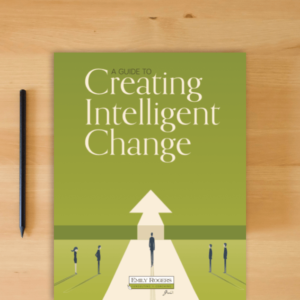Ready or not, it’s coming. Change, that is. Seventy-seven percent of human resource practitioners and leaders report that their organization is in a state of constant change. This latest research, conducted by the International Coach Federation and Human Capital Institute validates what many people in organizations around the nation are experiencing – continuously shifting priorities and strategies.
Change can be difficult and people often resist it. If your team is not prepared for change, keeping up with the pace of change, and willing to embrace change, your organization risks becoming irrelevant.
Regardless of whether you have committed to making proactive changes in your organization or you are reacting to conditions that require you and your team to change, the most significant challenge associated with creating change is getting stakeholder buy-in.
A two-year study, Change Is the New Normal, conducted by IBM, clearly identifies why getting buy-in for change is difficult and why only 20% of leaders feel successful in managing change.
- 58% of leaders said changing mindsets and attitudes is the most challenging aspect of change.
- 49% said changing the organizational culture was the most challenging aspect of change.
Without mindset shifts and an organizational culture that supports the change process, getting buy-in for a change initiative is simply impossible. Successful transformation requires that you change more than just the structure and operations of an organization— it requires that you change people’s behavior. And that is never easy.
A lot has been written on the topic of change management and how it should be implemented. My experience has been that before you can “manage” change successfully, you must cultivate an adaptive organizational culture and collaborative mindsets among team members. These qualities build the necessary foundation for the development of an agile workplace and ultimately, successful management of the change process.
In order to gain buy-in for change, the people impacted by it must first understand why it is happening. Leaders should answer questions like – “What were the signs indicating change is needed?” and “What is at stake if change does not occur?” so that team members are clear about what is driving the change.
Also, leaders must paint an inspiring picture of how both stakeholders and the organization will be better served as a result of the change. Often leaders rely too heavily on data and analysis to achieve buy-in instead of using powerful imagery that appeals to emotions. Sharing a powerful future vision that sparks motivation is a more compelling reason for team members to become engaged and move to action.
Once the vision for change is established, those that will be impacted by the change will need some time to process the new information and consider the potential impact it will have on the way they work and collaborate with others. If this time to process is not honored, achieving buy-in will be difficult. Team members won’t understand the change, won’t embrace the change, and won’t be willing to work toward overcoming the obstacles to change.
The approach of “slowing down to dialogue” versus “speeding up to dictate” is critical in times of uncertainty and change. Keep lines of communication open by creating an inclusive forum for team members to ask questions, debate, and generate new ideas. This is crucial during the buy-in phase and is an opportunity to reinforce trust and grow your organization’s capacity to work through a state of productive conflict.
When the need for change becomes meaningful to most everyone in the organization, a sense of shared purpose will emerge and greatly contribute to the commitment levels necessary to execute. Not everyone will embrace the change and leaders need to be prepared to address this in a way that serves the organizational change that must occur.
Finally, as the change process is unfolding, senior leaders must stay aligned and model a culture of collaborative, consistent, and results-oriented teamwork. If alignment is not occurring at the most senior levels of the organization, cross-functional mid-level teamwork will unravel and progress will stall.
Change truly is “the new normal”. The time required to successfully gain buy-in is essential to any change process and creates a much greater likelihood of successful and sustainable change management.
Download the Guide to Creating Intelligent Change

